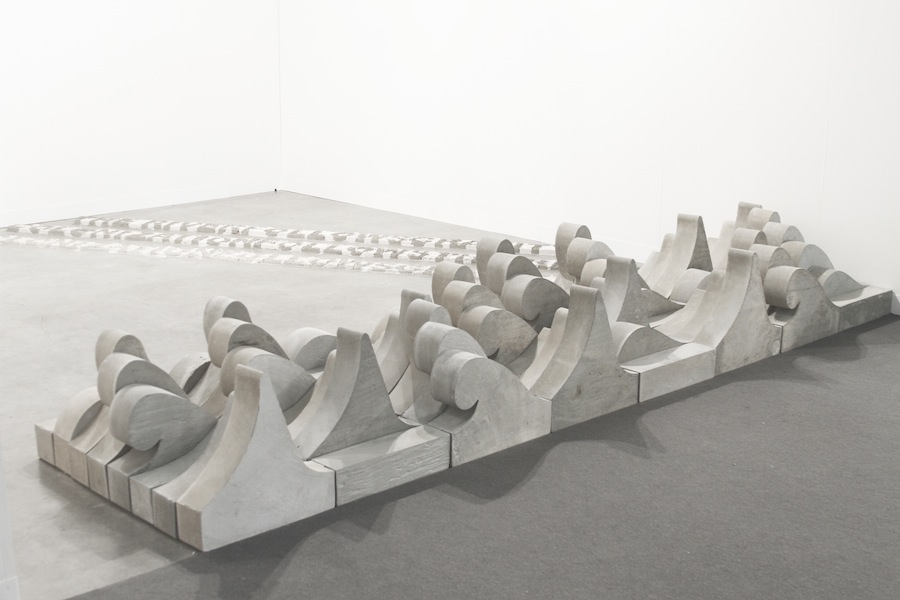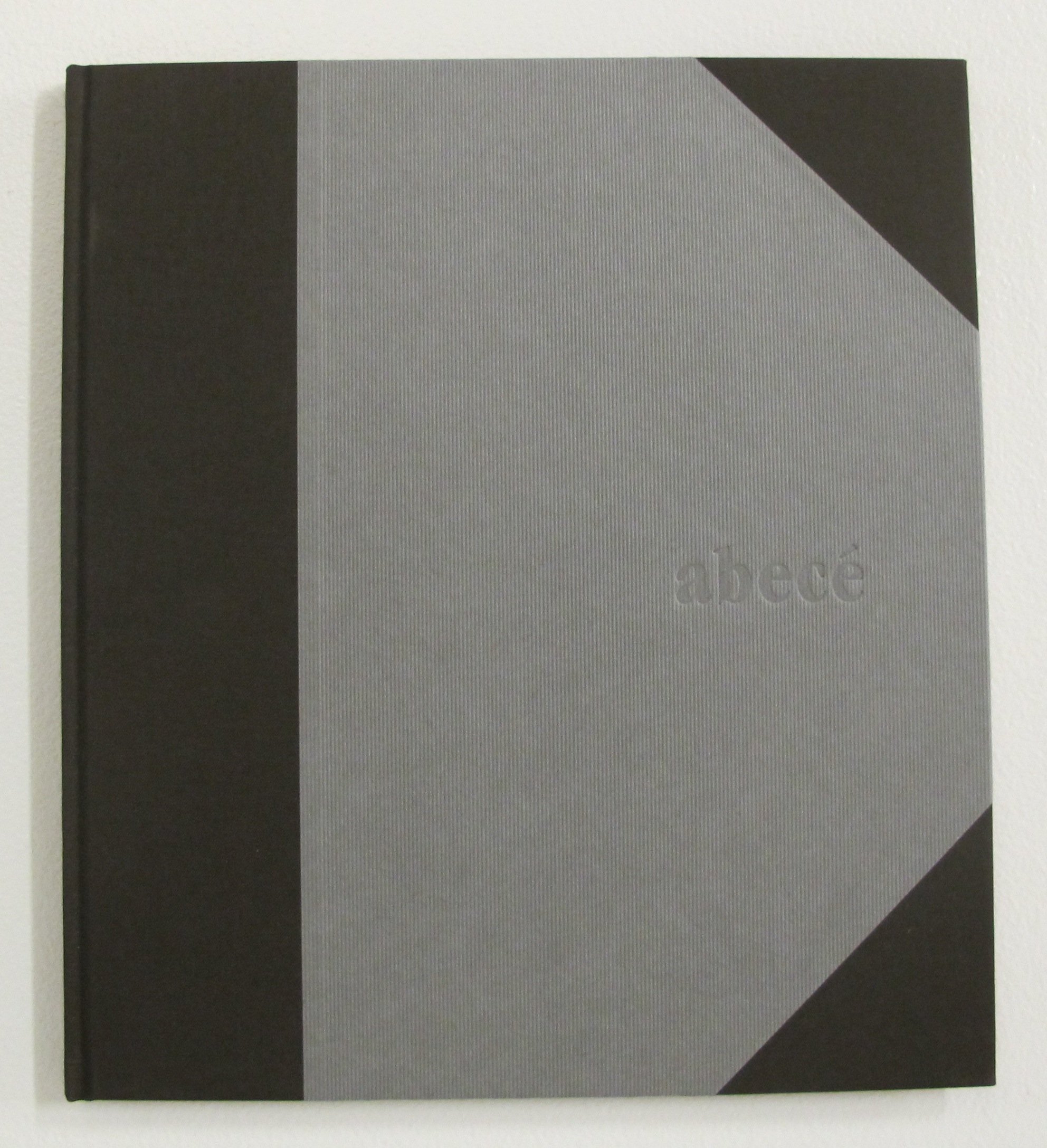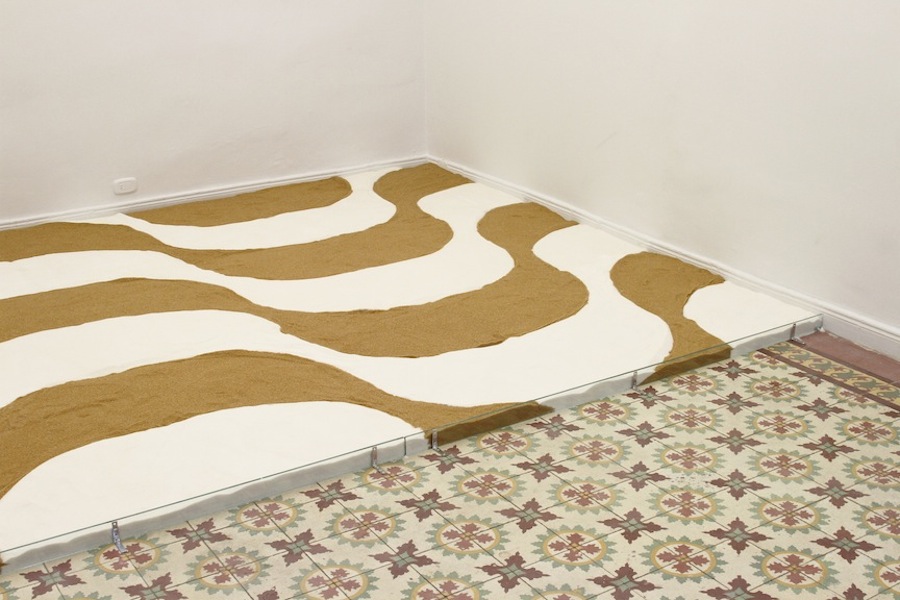
© » KADIST
Felipe Arturo
Primero estaba el mar ( First Was the Sea , 2012) is a system of equivalences between syllables and silhouettes of waveforms cast in cement. Each waveform represents a syllable of the sentence “Primero estaba el mar.” This sentence is the first verse of the Kogui poem of creation. For the Koguis, an indigenous community from the Sierra Nevada de Santa Marta on the Colombian Caribbean coast, water was the absolute presence before the creation of the universe.

© » KADIST
Johanna Calle
Drawing & Print (Drawing & Print)
Johanna Calle’s Abece “K” (2011) is part of a series of drawings (compiled into an artist book called Abece ) based on the alphabet. There is a drawing for each letter, in which the letter is repeated over and again in various directions and scales, thereby demonstrating how a symbol can be reoriented without changing its linguistic meaning. Here, the letter K is outlined and surrounded by a dense and varied field of other K s.

© » KADIST
Nicolás Paris
Nicolas Paris studied architecture and worked as an elementary school teacher before he decided to become an artist. Both of those interests feed deeply into his artistic practice, which ranges from workshops, dialogues, and exchanges to environments, drawings, and sculpture. Metaphors of the presence or conversations at the speed of light (2012) is a sculpture of a lightbulb that the artist altered.

© » KADIST
Mateo Lopez
With Roca Carbón (Charcoal Rock, 2012) and Roca Grafito ( Graphite Rock , 2012), López plays with our relationship to inert and unremarkable objects such as rocks. Traces of art history reverberate through the sculptures; their mediums reflect traditional materials for drawing and sketching, and the simplicity of their forms gesture toward minimalism. But López dislocates these common objects from their ordinary utility by replicating their component parts in paper, graphite, and charcoal, thus drawing attention to mechanisms of representation and translation.

© » KADIST
Bernardo Ortiz
Drawing & Print (Drawing & Print)
Casa de la cabeza (2011) is a drawing of the words of the title, which translate literally into English as “house of the head.” Ortiz uses this humorous phrase to engage the idea of living in your head.

© » KADIST
Mateo Lopez
Mateo Lopez uses paper as a medium to conjure personal experiences. The artist creates drawings and trompe l’oeil objects, ranging from apples to clothing hangers to doors. These props are part of a performance; he often sets up his studio in public and uses cues from his own journeys as the inspiration for his work.

© » KADIST
Felipe Arturo
Defined as entropy, the second law of thermodynamics proposes that energy is more easily dispersed than it is concentrated. One basic illustration of entropy is to imagine white and black sand: once mixed together, it is highly unlikely that the contrasting grains of sand can be separated and restored to their original distinct color groups. Arturo’s Trópico Entrópico ( Entropic Tropics , 2012) considers the colonization of the American continent as a similarly irreversible process of cultural entropy.

© » KADIST
Mateo Lopez
With Roca Carbon ( Charcoal Rock , 2012) and Roca Grafito ( Graphite Rock , 2012), López plays with our relationship to inert and unremarkable objects such as rocks. Traces of art history reverberate through the sculptures; their mediums reflect traditional materials for drawing and sketching, and the simplicity of their forms gesture toward minimalism. But López dislocates these common objects from their ordinary utility by replicating their component parts in paper, graphite, and charcoal, thus drawing attention to mechanisms of representation and translation.

© » KADIST
Johanna Calle
Drawing & Print (Drawing & Print)
Calle’s drawings all inhabit received forms but alter them to call attention to specific qualities. A newspaper is both reproduced and modified to call attention to the newspaper as a means of information transmission. This also emphasizes the effect of various seemingly unimportant support mechanisms: the role of visual layout and images.
Mateo Lopez
- location: Bogota, Colombia
- year born: 1978
- gender: male
- nationality: Colombian
- home town: Bogota, Colombia
Johanna Calle
- location: Bogota, Colombia
- year born: 1965
- nationality: Colombian
- home town: Bogota, Colombia
Felipe Arturo
- year born: 1979
- gender: male
- nationality: Colombian
- home town: Bogota, Colombia
Bernardo Ortiz
- location: Bogota, Colombia
- year born: 1972
- gender: male
- nationality: Colombian
- home town: Bogota, Colombia
-
2000-2009
Johanna Calle
Drawing & Print
2003(Drawing & Print) Calle’s drawings all inhabit received forms but alter them to call attention to specific qualities...
-
2010-2019
Johanna Calle
Drawing & Print
2011(Drawing & Print) Johanna Calle’s Abece “K” (2011) is part of a series of drawings (compiled into an artist book called Abece ) based on the alphabet...
Bernardo Ortiz
Drawing & Print
2011(Drawing & Print) Casa de la cabeza (2011) is a drawing of the words of the title, which translate literally into English as “house of the head.” Ortiz uses this humorous phrase to engage the idea of living in your head....
Felipe Arturo
2012Primero estaba el mar ( First Was the Sea , 2012) is a system of equivalences between syllables and silhouettes of waveforms cast in cement...
Nicolás Paris
2012Nicolas Paris studied architecture and worked as an elementary school teacher before he decided to become an artist...
Mateo Lopez
2012With Roca Carbón (Charcoal Rock, 2012) and Roca Grafito ( Graphite Rock , 2012), López plays with our relationship to inert and unremarkable objects such as rocks...
Felipe Arturo
2012Defined as entropy, the second law of thermodynamics proposes that energy is more easily dispersed than it is concentrated...
Mateo Lopez
2012With Roca Carbon ( Charcoal Rock , 2012) and Roca Grafito ( Graphite Rock , 2012), López plays with our relationship to inert and unremarkable objects such as rocks...
